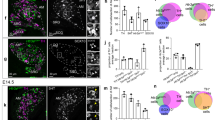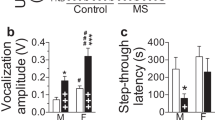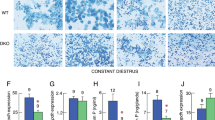Abstract
Corticotropin-releasing hormone (CRH) is both a main regulator of the hypothalamic-pituitary-adrenocortical axis and the autonomic nervous system. CRH receptor type 1 (CRHR1)-deficient mice demonstrate alterations in behavior, impaired stress responses with adrenocortical insufficiency and aberrant neuroendocrine development, but the adrenal medulla has not been analyzed in these animals. Therefore we studied the production of adrenal catecholamines, expression of the enzyme responsible for catecholamine biosynthesis neuropeptides and the ultrastructure of chromaffin cells in CRHR1 null mice. In addition we examined whether treatment of CRHR1 null mice with adrenocorticotropic hormone (ACTH) could restore function of the adrenal medulla. CRHR1 null mice received saline or ACTH, and wild-type or heterozygous mice injected with saline served as controls. Adrenal epinephrine levels in saline-treated CRHR1 null mice were 44% those of controls (P<0.001), and the phenylethanolamine N-methyltransferase (PNMT) mRNA levels in CRHR1 null mice were only 25% of controls (P <0.001). ACTH treatment increased epinephrine and PNMT mRNA level in CRHR1 null mice but failed to restore them to normal levels. Proenkephalin mRNA in both saline- and ACTH-treated CRHR1 null mice were higher than in control animals (215.8% P <0.05, 268.9% P <0.01) whereas expression of neuropeptide Y and chromogranin B did not differ. On the ultrastructural level, chromaffin cells in saline-treated CRHR1 null mice exhibited a marked depletion in epinephrine-storing secretory granules that was not completely normalized by ACTH-treatment. In conclusion, CRHR1 is required for a normal chromaffin cell structure and function and deletion of this gene is associated with a significant impairment of epinephrine biosynthesis.
This is a preview of subscription content, access via your institution
Access options
Subscribe to this journal
Receive 12 print issues and online access
$259.00 per year
only $21.58 per issue
Buy this article
- Purchase on Springer Link
- Instant access to full article PDF
Prices may be subject to local taxes which are calculated during checkout




Similar content being viewed by others
References
Chrousos GP, Gold PW . The concepts of stress and stress system disorders. Overview of physical and behavioral homeostasis JAMA 1992 267: 1244–1252
Bornstein SR, Chrousos GP . Clinical Review: adrenocorticotropin (ACTH)- and non-ACTH mediated regulation of the adrenal cortex. Neural and immune inputs J Clin Endocrinol Metab 1999 84: 1729–1736
Muglia LJ, Jacobson L, Weninger SC, Luedeke CE, Bae DS, Jeong KH, Majzoub JA . Impaired diurnal adrenal rhythmicity restored by constant infusion of corticotropin-releasing hormone in corticotropin-releasing hormone-deficient mice J Clin Invest 1997 99: 2923–2929
Muglia L, Jacobson L, Dikkes P, Majzoub JA . Corticotropin-releasing hormone deficiency reveals major fetal but not adult glucocorticoid need Nature 1995 373: 427–432
Coste SC, Kesterson RA, Heldwein KA, Stevens SL, Heard AD, Hollis JH et al. Abnormal adaptations to stress and impaired cardiovascular function in mice lacking corticotropin-releasing hormone receptor-2 Nat Genet 2000 24: 403–409
Timpl P, Spanagel R, Sillaber I, Kresse A, Reul JM, Stalla GK et al. Impaired stress response and reduced anxiety in mice lacking a functional corticotropin-releasing hormone receptor Nat Genet 1998 19: 162–166
Smith GW, Aubry JM, Dellu F, Contarino A, Bilezikjian LM, Gold LH et al. Corticotropin releasing factor receptor 1-deficient mice display decreased anxiety, impaired stress response, and aberrant neuroendocrine development Neuron 1998 20: 1093–1102
Bale TL, Contarino A, Smith GW, Chan R, Gold LH, Sawchenko PE et al. Mice deficient for corticotropin-releasing hormone receptor-2 display anxiety-like behaviour and are hypersensitive to stress Nat Genet 2000 24: 410–414
Stenzel-Poore MP, Duncan JE, Rittenberg MB, Bakke AC, Heinrichs SC . CRH overproduction in transgenic mice: behavioral and immune system modulation Ann N Y Acad Sci 1996 780: 36–48
Stenzel-Poore MP, Cameron VA, Vaughan J, Sawchenko PE, Vale W . Development of Cushing's syndrome in corticotropin-releasing factor transgenic mice Endocrinology 1992 130: 3378–3386
Burrows HL, Nakajima M, Lesh JS, Goosens KA, Samuelson LC, Inui A et al. Excess corticotropin releasing hormone-binding protein in the hypothalamic-pituitary-adrenal axis in transgenic mice J Clin Invest 1998 101: 1439–1447
Ehrhart-Bornstein M, Hinson JP, Bornstein SR, Scherbaum WA, Vinson GP . Intraadrenal interactions in the regulation of adrenocortical steroidogenesis Endocr Rev 1998 19: 101–143
Axelrod J, Reisine TD . Stress hormones: their interaction and regulation Science 1984 224: 452–459
Wurtman RJ, Axelrod J . Control of enzymatic synthesis of adrenaline in the adrenal medulla by adrenal cortical steroids J Biol Chem 1966 241: 2301–2305
Cole TJ, Blendy JA, Monaghan AP, Krieglstein K, Schmid W, Aguzzi A et al. Targeted disruption of the glucocorticoid receptor gene blocks adrenergic chromaffin cell development and severely retards lung maturation Genes Dev 1995 9: 1608–1621
Bornstein SR, Tajima T, Eisenhofer G, Haidan A, Aguilera G . Adrenomedullary function is severely impaired in 21-hydroxylase-deficient mice FASEB J 1999 13: 1185–1194
Merke DP, Chrousos GP, Eisenhofer G, Weise M, Keil MF, Rogol AD et al. Adrenomedullary dysplasia and hypofunction in patients with classic 21-hydroxylase deficiency N Engl J Med 2000 343: 1362–1368
Bornstein SR, Breidert M, Ehrhart-Bornstein M, Kloos B, Scherbaum WA . Plasma catecholamines in patients with Addison's disease Clin Endocrinol (Oxf) 1995 42: 215–218
Willenberg HS, Bornstein SR, Hiroi N, Path G, Goretzki PE, Scherbaum WA, Chrousos GP . Effects of a novel corticotropin-releasing-hormone receptor type I antagonist on human adrenal function Mol Psychiatry 2000 5: 137–141
Hoheisel G, Schauer J, Scherbaum WA, Bornstein SR . The effect of corticotropin-releasing hormone (CRH) on the adrenal medulla in hypophysectomized rats Histol Histopathol 1998 13: 81–87
Venihaki M, Gravanis A, Margioris AN . Comparative study between normal rat chromaffin and PC12 rat pheochromocytoma cells: production and effects of corticotropin-releasing hormone Endocrinology 1997 138: 698–704
Eisenhofer G, Goldstein DS, Stull R, Keiser HR, Sunderland T, Murphy DL, Kopin IJ . Simultaneous liquid-chromatographic determination of 3,4-dihydroxyphenylglycol, catecholamines, and 3,4-dihydroxyphenylalanine in plasma, and their responses to inhibition of monoamine oxidase Clin Chem 1986 32: 2030–2033
Heid CA, Stevens J, Livak KJ, Williams PM . Real time quantitative PCR Genome Res 1996 6: 986–994
Vale W, Spiess J, Rivier C, Rivier J . Characterization of a 41 residue ovine hypothalamic peptide that stimulates secretion of corticotropin and beta-endorphin Science 1981 213: 1394–1397
Koob GF, Heinrichs SC, Menzaghi F, Pich EM, Britton KT . Corticotropin releasing factor, stress and behavior Sem in the Neurosci 1994 6: 221–229
Sutton RE, Koob GF, Le Moal M, Rivier J, Vale W . Corticotropin releasing factor produces behavioural activation in rats Nature 1982 297: 331–333
Bornstein SR, Ehrhart-Bornstein M, Güse-Behling H, Scherbaum WA . Structure and dynamics of adrenal mitochondria following stimulation with corticotropin releasing hormone Anat Rec 1992 234: 255–262
Nussdorfer GG . Cytophysiology of the adrenal cortex Int Rev Cytol 1986 98: 1–405
Bornstein SR, Ehrhart-Bornstein M, Scherbaum WA . Morphological and functional studies of the paracrine interaction between cortex and medulla in the adrenal gland Microsc Res Tech 1997 36: 520–533
Bland ML, Jamieson CA, Akana SF, Bornstein SR, Eisenhofer G, Dallman MF, Ingraham HA . Haploinsufficiency of steroidogenic factor-1 in mice disrupts adrenal development leading to an impaired stress response Proc Natl Acad Sci USA 2000 97: 14488–14493
Habib KE, Weld KP, Rice KC, Pushkas J, Champoux M, Listwak S et al. Oral administration of a corticotropin-releasing hormone receptor antagonist significantly attenuates behavioral, neuroendocrine, and autonomic responses to stress in primates Proc Natl Acad Sci USA 2000 97: 6079–6084
Briscoe RJ, Cabrera CL, Baird TJ, Rice KC, Woods JH . Antalarmin blockade of corticotropin releasing hormone-induced hypertension in rats Brain Res 2000 881: 204–207
Karalis KP, Kontopoulos E, Muglia LJ, Majzoub JA . Corticotropine-releasing hormone deficiency unmasks the proinflammatory effect of epinephrine Proc Natl Acad Sci USA 1999 96: 7093–7097
Ebert SN, Ficklin MB, Her S, Siddall BJ, Bell RA, Ganguly K et al. Glucocorticoid-dependent action of neural crest factor AP-2: stimulation of phenylethanolamine N-methyltransferase gene expression J Neurochem 1998 70: 2286–2295
Ebert SN, Wong DL . Differential activation of the rat phenylethanolamine N-methyltransferase gene by Sp1 and Egr-1 J Biol Chem 1995 270: 17299–17305
Wong DL, Siddall BJ, Ebert SN, Bell RA, Her S . Phenylethanolamine N-methyltransferase gene expression: synergistic activation by Egr-1, AP-2 and the glucocorticoid receptor Brain Res Mol Brain Res 1998 61: 154–161
Wong DL, Siddall B, Wang W . Hormonal control of rat adrenal phenylethanolamine N-methyltransferase. Enzyme activity, the final critical pathway Neuropsychopharmacology 1995 13: 223–234
Viveros OH, Diliberto EJ Jr, Hong JH, Kizer JS, Unsworth CD, Kanamatsu T . The regulation of enkephalin levels in adrenomedullary cells and its relation to chromaffin vesicle biogenesis and functional plasticity Ann N Y Acad Sci 1987 493: 324–341
O'Connor DT, Klein RL, Thureson-Klein AK, Barbosa JA . Chromogranin A: localization and stoichiometry in large dense core catecholamine storage vesicles from sympathetic nerve Brain Res 1991 567: 188–196
Dillen L, Miserez B, Claeys M, Aunis D, De Potter W . Posttranslational processing of proenkephalins and chromogranins/secretogranins Neurochem Int 1993 22: 315–352
Tran MA, Damase-Michel C, Tavernier G, Giraud P, Montastruc JL, Montastruc P . Co-release of neuropeptides and catecholamines by adrenal medulla Arch Mal Coeur Vaiss 1993 86: 1253–1256
Bastiaensen E, De Block J, De Potter WP . Neuropeptide Y is localized together with enkephalins in adrenergic granules of bovine adrenal medulla Neuroscience 1988 25: 679–686
Brimijoin S, Dagerlind A, Rao R, McKinzie S, Hammond P . Accumulation of enkephalin, proenkephalin mRNA, and neuropeptide Y in immunologically denervated rat adrenal glands: evidence for divergent peptide regulation J Neurochem 1995 64: 1281–1287
Fischer-Colbrie R, Iacangelo A, Eiden LE . Neural and humoral factors separately regulate neuropeptide Y, enkephalin, and chromogranin A and B mRNA levels in rat adrenal medulla Proc Natl Acad Sci USA 1988 85: 3240–3244
Stachowiak MK, Hong JS, Viveros OH . Coordinate and differential regulation of phenylethanolamine N-methyltransferase, tyrosine hydroxylase and proenkephalin mRNAs by neural and hormonal mechanisms cultured bovine adrenal medullary cells Brain Res 1990 510: 277–288
Wan DC, Marley PD, Livett BG . Coordinate and differential regulation of proenkephalin A and PNMT mRNA expression in cultured bovine adrenal chromaffin cells: responses to cAMP elevation and phorbol esters Brain Res Mol Brain Res 1991 9: 135–142
Eiden LE, Giraud P, Affolter HU, Herbert E, Hotchkiss AJ . Alternative modes of enkephalin biosynthesis regulation by reserpine and cyclic AMP in cultured chromaffin cells Proc Natl Acad Sci U S A 1994 81: 3949–3953
Eiden LE, Giraud P, Dave JR, Hotchkiss AJ, Affolter HU . Nicotinic receptor stimulation activates enkephalin release and biosynthesis in adrenal chromaffin cells Nature 1984 312: 661–663
Bornstein SR, Tian H, Haidan A, Böttner A, Hiroi N, Eisenhofer G et al. Deletion of tyrosine hydroxylase gene reveals functional interdependence of adrenocortical and chromaffin cell system in vivo Proc Natl Acad Sci U S A 2000 97: 14742–14747
Böttner A, Haidan A, Eisenhofer G, Kristensen K, Castle AL, Scherbaum WA et al. Increased body fat mass and suppression of circulating leptin levels in response to hypersecretion of epinephrine in phenylethanolamine-N-methyltransferase (PNMT)-overexpressing mice Endocrinology 2000 141: 4239–4246
Böttner A, Bornstein SR . Lessons learned from gene targeting and transgenesis for adrenal physiology and disease Rev Endo Metab Dis 2001 2: 275–287
Quaife CJ, Hoyle GW, Froelick GJ, Findley SD, Baetge EE, Behringer RR et al. Visualization and ablation of phenylethanolamine N-methyltranferase producing cells in transgenic mice Transgenic Res 1994 3: 388–400
Author information
Authors and Affiliations
Corresponding author
Rights and permissions
About this article
Cite this article
Yoshida-Hiroi, M., Bradbury, M., Eisenhofer, G. et al. Chromaffin cell function and structure is impaired in corticotropin-releasing hormone receptor type 1-null mice. Mol Psychiatry 7, 967–974 (2002). https://doi.org/10.1038/sj.mp.4001143
Received:
Revised:
Accepted:
Published:
Issue Date:
DOI: https://doi.org/10.1038/sj.mp.4001143
Keywords
This article is cited by
-
The 3D in vitro Adrenoid cell model recapitulates the complexity of the adrenal gland
Scientific Reports (2024)
-
Effects of Trilostane on urinary Catecholamines and their metabolites in dogs with Hypercortisolism
BMC Veterinary Research (2017)
-
The adrenal gland microenvironment in health, disease and during regeneration
Hormones (2017)
-
The corticotrophin-releasing factor/urocortin system regulates white fat browning in mice through paracrine mechanisms
International Journal of Obesity (2015)
-
Adrenal Responses to Stress
Cellular and Molecular Neurobiology (2010)



